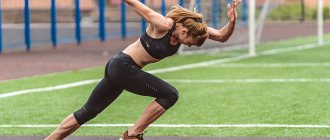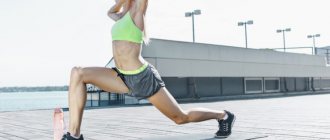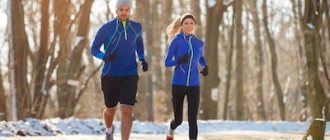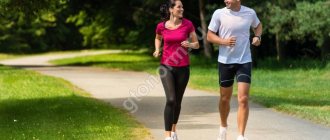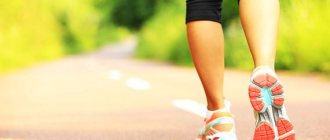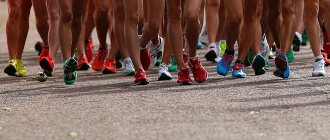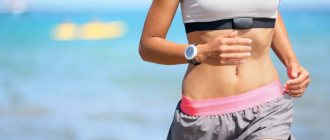Improving running technique is a fascinating and endless process. Special running exercises, general physical training, slides, short accelerations - all this mockery is aimed at strengthening the muscles involved in running and developing the correct movements. But in order to get rid of old habits and instill new, correct ones, this is not enough - you will have to connect the brain.
I am sharing a free translation of an article (English source) that I found useful. Thanks to Vanya rempi for the link.
Running technique exercises
The idea behind the running technique exercises below is to use your body awareness (cleverly called proprioception) to change your movement patterns and develop proper running movement patterns.
It’s clear that you can’t get by with just a developed imagination. No matter how hard you imagine that, for example, you are running through water, pushing off quickly and strongly - if the muscles are weak and do not allow you to do this, then it is unlikely that anything good will work out. But it also happens that physically the body can already run better and more efficiently, but old habits, things that we do automatically and without thinking, get in the way. In this case, the conscious use of such techniques will allow you to achieve the necessary changes.
For these exercises to produce results, you will need to concentrate and not have your thoughts in the clouds, as we often do while running. To really improve your running technique, each exercise must be performed with full concentration on it and devoting a sufficiently long time to it.
You shouldn’t expect magical improvements right away: changing the motor stereotypes that underlie habitual techniques, developing a new movement skill and bringing it to automatism is not so easy and takes time.
Exercise Tips
- do only one exercise throughout your run, practicing the skill at least 3 times a week
- To begin with, it is better to practice during light recovery workouts
- exercise may cause muscle fatigue to occur more quickly than usual because... use muscles differently than they are used to working
- There is no need to practice each skill to perfection before moving on to the next. The best option is to work on each of the exercises sequentially, then return to the first one again, and so on, in a circle. Even if your running technique has improved markedly, it doesn't hurt to do it regularly to keep it from falling apart, especially when you're tired.
When to do the exercises
Now that you have become acquainted with the list of exercises, I will offer you the option of introducing them into your training schedule. Incorporating running technique exercises will only add 5-15 minutes to each of your workouts.
Sunday - long run
Before you start running: lunges
At the end of the run: 6 short bursts, core exercises - 5 repetitions of each exercise
Monday – recovery run
Before you start running: lunges
At the end of the run: core exercises - 10 repetitions of each exercise
Tuesday – training including speed/tempo work
Before starting the run: easy jogging, walking with a high hip lift - 2 tracks of 20 meters, running with a high hip lift - 2 tracks of 20 meters, 4 accelerations.
At the end of the run: squats - 3-4 series of 6-8 repetitions.
Wednesday – recovery run
Before you start running: lunges
At the end of the run: 20 short bursts, core exercises - 5 repetitions of each exercise
Thursday - recovery run
Before you start running: core exercises - 5 repetitions each
At the end of the run: lunges
Friday – training including speed/tempo work
Before starting the run: easy jogging, walking with a high hip lift - 2 tracks of 20 meters, running with a high hip lift - 2 tracks of 20 meters, 4 accelerations.
At the end of the run: squats - 3-4 series of 6-8 repetitions.
Saturday - closed
And an important thought in conclusion. Change takes time. Do these exercises regularly, be patient, and the results will definitely come!
Original article
Translation - Olga Polyakova
Subscribe to our Telegram channel (@strela_coach) and read new articles!
Recommendations for you:
Move your elbows back to run faster
Feet: take care of them and strengthen them
Body position while running - why is it important?
6 Upper Body Exercises to Improve Your Running Technique
Core workout
How to do a plank correctly
How running on different surfaces affects your body
Find your optimal running cadence
Microdose training to adapt to stress
Falling forward
Lean your body forward slightly as you run. It is important not to bend at the waist, but to bend over completely, starting from the knees. When performing the exercise for the first time, you may try to lean forward more than necessary, almost falling. Then return to a comfortable, controlled position where you feel gravity pulling you forward.
This exercise helps you get rid of the habit of taking too wide steps and landing in front of your center of gravity. Leaning forward slightly will place your feet naturally under your center of gravity.
And to professionalism
It's hard to believe, but man is tougher than any animal. In terms of maximum acceleration, it is inferior to many animals, but in terms of running over significant distances, it is faster even than a horse, not to mention “sprinters” such as a cheetah. With proper training, a person can run gigantic distances with short breaks to sleep. Moreover, humans have the most developed of all animals gluteal muscles (those that most people hide under the fat below the back) - they do the lion's share of the work while running. However, the whole body works.
In general, you shouldn’t think of running as “leaving the house and running.” You need a systematic approach to running - and then it becomes both interesting (at least, there is a desire to travel and run around different cities, collect medals from different races) and useful for the body. You need to choose the right shoes, approach your training schedule wisely, learn how to run correctly, and combine running with functional training to develop various muscle groups (the exercise machine known as TRX loops is especially useful here). And gradually you will get involved. And you want to run a marathon. Or a super marathon. Life is running, running, running.
The article “Running Sect” was published in the magazine “Popular Mechanics” (No. 8, August 2015).
Hip work
Focus on driving your hip forward with more force than you are used to. A stronger back/forward movement of the leg will help balance the other leg as it lands on the ground. Remember the movement of throwing a ball hard with one hand - the second hand moves in the opposite direction. If it is difficult to maintain attention on both legs at the same time, you can first work on extending one hip, and then connect the other. This exercise makes the movements of the two legs more coordinated, and the step stronger and more elastic.
Exercise Group 4 - Walking and Running with High Hip Raises
These two activities are exactly what their names say: you need to move your knees with increased range of motion compared to normal walking or running. At the same time, during exercises, it is important to try not to rotate your pelvis and keep your back straight. Also, to perform these exercises better, try to raise your legs so that your thighs are parallel to the floor, not higher.
Exercises:
Walking with a high hip lift:
Running with high hips:
Flexible relaxed feet
The human foot consists of 27 bones and dozens of muscles and ligaments. This clever design allows it to absorb shock when landing while running. Unfortunately, shoes limit this natural movement in many ways. Using shoes that allow the foot to move more freely will help bring it back (note: you should be careful with such experiments: natural running in minimalist shoes requires preparation and gradualness).
Focus on keeping your feet relaxed as you run. How does this combine with the strong elastic kicks of the legs on the ground from the previous exercise? They don’t go away, but occur mainly due to the work of the muscles of the upper legs. At the same time, the feet should remain in a relaxed state to absorb the shock load and reduce its impact on the tissue.
Run, Forrest, run! TOP 5 useful accessories for running
From that day on I could no longer walk. I could only run. Forrest Gump
A pair of sneakers and comfortable clothes are the bare minimum for running. But if you want to keep up with the times, make your runs more fun and comfortable, then you should expand your list of running accessories. Take advantage of the achievements of the sports industry to run faster, higher, stronger! Here are the TOP 5 useful items that runners actively use.
Heart rate watch with GPS
With them you can set measurable goals, motivate yourself, count training time, distance, heart rate, pace and even calories burned. And the built-in GPS sensor will allow you to build the route traveled when synchronized with a PC. Mark it on the map and show it off to your friends on social networks!
Garmin has a huge line of running watch models: women's, men's, unisex. When choosing a sports watch, remember, you are not buying it for beauty! Therefore, a large screen and convenient controls will only be a plus.
Where can I buy? On Amazon.com
Price: from 3700 rubles.
Running belt
Running clothes usually don't have a lot of pockets. Then the question arises: where to put your phone, keys, water bottle? Get a special belt for this!
The Fuel Belt fits around the waist and is secured with convenient Velcro. It has a pocket for small items and secure bottle holders. This is an irreplaceable thing, especially if you are running along a forest route where there are no storage rooms or changing rooms. Run and don’t be distracted by trifles - everything you need is at your fingertips!
Where can I buy? On Amazon.com
Price: from 1000 rubles.
Sippy bottle
It is very important to stay hydrated while running. Therefore, be sure to take water with you, and to make it more convenient, pour it into a Clean Bottle! Unlike regular bottles, it does not leak. And you won’t have any difficulties cleaning it from the inside, because the manufacturer has provided a twist-off bottom.
Many models are improved with a special filter system. You can fill this bottle with water straight from the tap without fear for your health!
Where can I buy? On Amazon.com
Price: from 380 rubles.
MP3 player with flashlight function
Do you like to run with music in the evenings? Then you will need not only a player, but also a flashlight. The DRUM device from teXet combines these two useful functions.
The company created this gadget as an MP3 player for cyclists, but the device is also very convenient for runners. Small dimensions allow you to carry it with you. DRUM can play music from a memory card or phone, play FM radio both through headphones and built-in speakers (the volume is impressive!). And the flashlight can illuminate your path up to 5 meters!
Where can I buy? On Yandex.Market
Price: 1690 rubles.
Smartphone holder for hand
Do you prefer to run with mobile applications or listen to your favorite music on your phone? You will definitely like this armband with a phone holder function. Its diameter is easily adjustable with Velcro, it's easy to clean, and even has a small pocket for money and other small items you might need while running.
Where can I buy? On AliExpress
Price: from 120 rubles.
So, you already understand that the sports industry does not stand still. There are plenty of devices on the market that can improve the efficiency of your runs. Before setting Olympic records, arm yourself with useful accessories. And run, Forrest, run!
Feeling of symmetry
Focus your attention on a part of your body or your step, paying attention to both the left and right sides. For example, you can focus on arm movement, hip extension, foot placement, push, etc. Compare the sensations on the left and right sides of the body. If there are discrepancies between them, try to correct them or at least reduce them, and also pay more attention to the side on which the movements feel less comfortable and natural. The exercise is aimed at reducing asymmetry.
Sports watches
A sports watch or fitness tracker is an almost essential accessory for those who get into running. Wearable technology is for runners who want to better understand their training performance, analyze their progress, and track recovery after exercise.
The range, choice and price range on the market is huge, so let’s focus on the general details.
Three types of wearable gadgets are suitable for runners: fitness trackers, sports heart rate monitors, smart watches.
- A fitness tracker is a bracelet with a screen, usually inexpensive and with a limited number of functions. It is able to count your heart rate and number of steps, but most often it is inaccurate. Allows you to analyze overall activity. Prices are up to 10 thousand rubles.
- A sports heart rate monitor is an advanced counterpart to a fitness tracker, capable of analyzing activity independently, that is, without a phone, recording them and creating training programs, tracking and analyzing sleep. This is the very type of gadget that is indispensable for runners who regularly train by heart rate and strive for progress. These gadgets have no problem integrating seamlessly with major fitness apps. Prices range from budget models for 15-20 thousand rubles to the premium segment for 60 thousand rubles.
- A smart watch is a mini-smartphone on your wrist. In general, they can do everything a phone can, including counting your pulse. But the disadvantages are quick discharge and price. Almost all smartwatches cost around 30 thousand rubles and above.
Among all the listed types, the second one is suitable for serious runners - sports watches. The top three manufacturers are Garmin, Polar and Suunto.
Mastering the technique of performing a high start
Before giving commands, the athlete must be at a distance of 1.5-2 m from the start line. When commanding “Go to the start”, the athlete places the starting leg forward with the foot, while the toe is placed directly in front of the starting line.
The other leg, which is the fly leg, moves half a step back, resting on the front half of the foot. The feet are placed so that they are parallel to each other along the trajectory of movement. The start is carried out in a relaxed state of the muscles.
With the “Attention” command, the athlete transfers his body weight to the other leg, his legs bend at the knees, his torso goes forward, his arms bend at the elbows, and the arm opposite the pushing leg is brought forward. Or the bent arm can be lowered down while in a bent position.
Belts for starting number
A small thing, it would seem, but a very useful thing - a belt or belt for the starting number. For those who regularly participate in mass races, who don't want to have pins making holes in their T-shirts, who don't like to run with a number in their hand and risk losing it along the way, they need a race number belt.
The number is fixed on different fastening systems, depending on the model: most often these are ropes with a plastic lock. They are threaded through holes on the number.
- There are models of running belts that can also hold gels and even water bottles. Some have pockets where a phone can fit.
- There are more complex models. For example, the Compressport Free Belt Pro is a fastener for both the starting number and trekking poles used by trail runners, and additional pockets for a 250 ml bottle, gels and a compression belt to support the back and core muscles.
- Another option for fastening the starting number is magnets. Four magnets from two circles fix the number on clothes - one magnet under the clothes, the second on top. Such magnets are always very strong; they hold the number even through fleece. The main thing is not to lose the magnets themselves when you remove the number at the finish line.
Prices for simple belts for a runner's number fluctuate around 1 thousand rubles; for more advanced models the price reaches 3 thousand rubles. Magnets for the number also cost around 1 thousand rubles.
Running gloves
Another important accessory for winter running is gloves. Essentially, their task is to save your hands from cold, snow and wind and to do it so that it does not get hot. There are, however, several nuances.
- Choose technical fabrics. Gloves must dry quickly and get wet as little as possible, otherwise they will be of no use.
- Choose a glove size so that it fits like a second skin—tight, but not too tight. The palms may begin to swell due to pressure.
- Choose models for touch screens so that you don’t have to take off your gloves and feel cold when you need to use your mobile phone. It is also a good idea for the gloves to have reflective elements.
- In frosts down to -30 degrees, it is better to wear gloves and mittens. Mittens will provide good warmth, but gloves are needed to, for example, remove mittens and tie shoelaces without freezing your hands.
- Gloves can come in handy even in summer. For example, when running in the mountains, they will protect your hands if the runner starts clinging to rocks.
Running sleeves
Running sleeves can work much like gaiters - as compression gear and improve circulation in your arms.
Another useful feature is protection in cool weather and the ability to remove the sleeves if it gets too hot. This is especially true for competitions, when it may be cool at the start, but during the race it becomes hot.
Remember your feet
When working on this point, special attention should be paid to the correct placement of both legs. It would also be incorrect for the athlete to move his chin back during the first step. This leads to disruption of the running rhythm and general coordination at the beginning of the movement, during which a rapid increase in speed is impossible. The chin turns up, which inevitably leads to the body straightening too quickly. It is also necessary to control this moment - monitor the work of the chin, which should be lowered and pressed to the chest.
If the hips rise too high on the first step, then the step will be too short and will immediately deprive the participant of the advantage. Therefore, the foot should be positioned low in relation to the running surface.
Reflectors for running
Any high-quality running equipment has reflective elements. This is a truly important element for the safety of runners at night. If these elements are not on your clothes, you can buy them and attach them to your clothes additionally.
- Reflective keychains, flickers and pennants; reflective bracelets; clippers.
- You can even buy a reflective vest, like what motorists buy. By the way, it is ten times cheaper than a special running jacket.
- The best points for placing reflectors are front and back, on the sleeves, chest, and lower back.
Long distance running technique
Long-distance running includes the popular 5 and 10 kilometer races, as well as 20, 25, 30 and 42 kilometres. Preparation for the race begins long before it starts. It is very important to create the right training program and strictly adhere to it to achieve the best results. The training will be based on the development of:
- speed;
- endurance;
- correct movements.
The technique of running over any distance includes the correct positioning of the arms, legs and body.
The technique of long-distance running includes the start, acceleration, main distance and finish.
At the start, the pushing leg is on the line, and the swing leg is behind. The torso is tilted forward, arms are bent at the elbows. The body straightens after the start gradually in the first 100 meters of the distance, when acceleration occurs. The main distance should be run at the same speed, allowing you to save energy for finishing. Acceleration towards the finish begins in the last 200-150 meters of the distance. As you accelerate, your torso tilt increases, your arms begin to work more actively, and your step width increases.
Headlamps
A running headlamp is often required equipment for trail runs. But the flashlight should be specifically for running, special, with certain characteristics for convenience and safety.
- A headlamp for running should be powerful – 200 lumens minimum.
- A running flashlight should be waterproof. Look for the abbreviation IPX4 - this means that the flashlight will withstand rain and snow.
- A running flashlight needs a diffuser - the light will cover a large area, which is critical on rough terrain and on descents.
- It is desirable to automatically adjust the brightness, which will adjust the glow power to natural light.
- It is better to take a headlamp for running with a convenient and easily adjustable angle adjustment.
- When buying a lantern, check that it does not move off your head, does not put pressure on it, and that it fits tightly. The fastening should be on an elastic band and complemented by a belt on the top of the head. This distributes the weight of the accessory.
- Brands – Petzl Myo, Bindi, Reactik, Nao, Black Diamond Icon, Revolt. Prices range from 1 to 6 thousand rubles.
Features of initial training
Before you start learning the technique of performing a high start, you can run out of a “falling” position. To do this, the athlete rests on his feet, shoulders in front, without any bending in the hip joints. This position shows the "fall" forward, after which the start begins.
During the initial training period, it is necessary to carry out a detailed analysis of each starting command with an unlimited number of repetitions. The first training sessions from a high start position involve running a 15-20 meter race. Subsequently, the distance increases to 30-40 meters.
Improving long-distance running technique
- Constant training. The ideal amount of training is 3-4 training sessions per week.
- Register your results. It is worth systematically recording your results to track dynamics.
- Interval training. For example, alternating jogging with sprinting.
- Long runs. Continuous running 1-2 times a month for an hour.
- Use exercise equipment to train muscles and increase endurance. An exercise bike is ideal for this purpose.
- Running faster. With each run, accelerate the last 200-300 meters before the finish.
ATTENTION! When jogging, do not forget about monitoring your physical condition. To do this, you should visit the clinic once a year for a routine medical examination and master methods of self-monitoring of your condition.
Running glasses
Running glasses perform one function - eye protection. Many people may feel uncomfortable wearing glasses, which they perceive as a hindrance. But if you choose this accessory correctly, it will not cause discomfort.
- Running glasses are needed to protect your eyes from the sun, glare of light reflected from snow or water, to protect from branches, dirt, precipitation, insects - from anything that can disrupt your running pace and cause trouble.
- Running glasses are most often made of grilamid, a lightweight plastic ideal for this sports accessory.
- Good running glasses usually have UV protection on both sides of the lenses - inside and outside. Look for the abbreviations UVA and UVB. Darkening is indicated by numbers from 1 to 4 - from light to darker tones.
- It's better not to skimp on running glasses. Firstly, your face will sweat a lot under low-quality plastic. Secondly, cheap models are not technologically advanced and will not sit well on your head. Thirdly, cheap glasses have very poor UV protection on the lenses. Choose from the flagship brands District Vision, Spy, Sunski, Bolle, Julbo, Cebe, Oakley, adidas, Nike. Prices range from 2 to 10 thousand rubles.
Basic mistakes when issuing the “Start” command
The forward bend is greater than necessary, which pushes the shoulders beyond the starting line. This error makes it possible to leave the start line even before the “March” command. At the same time, the load on the pushing leg increases due to the fact that it holds the torso. In this regard, with the “March” command, the athlete spends extra effort on being able to start the race.
The knees are bent more than necessary. This error leads to the fact that the athlete will need to make extra efforts to get a quick start. In this case, there is an overexpenditure of effort and loss of time at the very beginning.
The shoulders may be tilted back or the torso may not be tilted but supported upright. This error leads to the fact that the first steps will be quite short due to the fact that the movement is directed upward, and not forward. The maximum possible speed of movement is achieved with a delay from other athletes.
Running backpacks
The most functional accessory among runners. It is most widely used in trail races, and some organizers specify a backpack as a mandatory accessory for participation.
- Running backpack sizes are measured in liters, and running backpacks come in sizes ranging from 2 to 20 liters. The small ones contain a minimum supply of food and water, and the large ones - food, water, mandatory equipment, and a change of clothes.
- Most models involve a built-in drinking system with a hose. Some models have mounts for trekking poles - two loops on the top and bottom on the outside of the backpack.
- The most difficult and responsible thing is to adjust the backpack to suit you. Straps and Velcro are responsible for this. The system works the same as with hiking backpacks. It is a properly fitted backpack that will sit as tightly as possible on your back and not dangle, as befits a running backpack.
This accessory is quite expensive, and the choice must be made according to basic parameters: volume and weight, what races it will be needed for, and most importantly, comfort, so it is better to try on the backpack in a store, putting some things in it. Prices vary from 2 to 10 thousand rubles.
